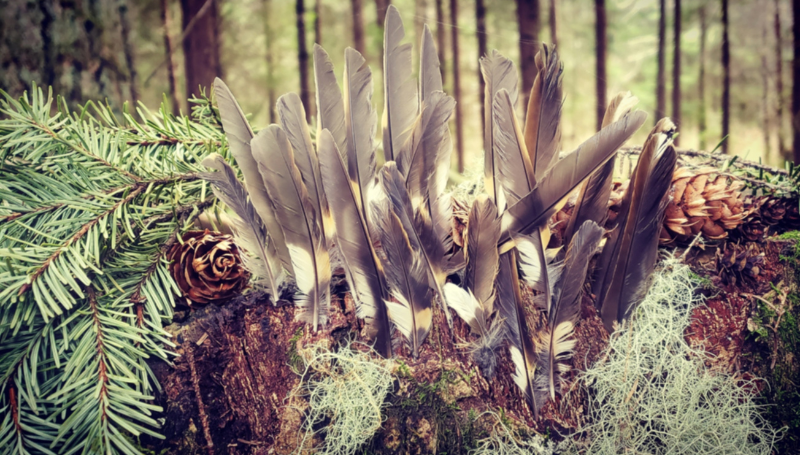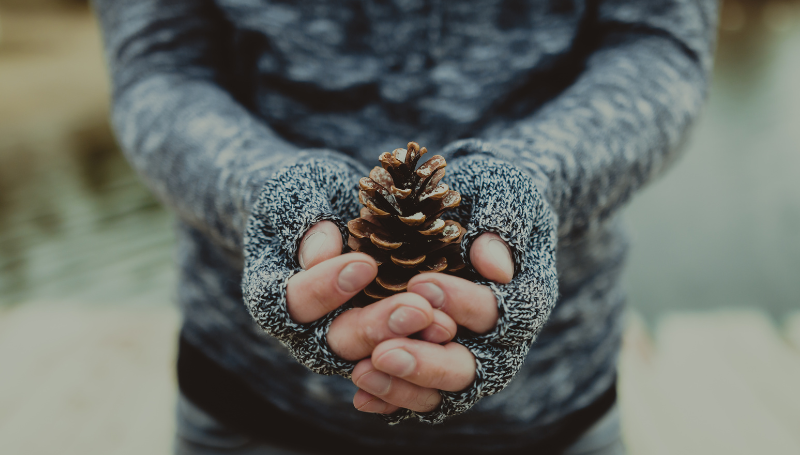Morning altars: a practice to nourish your spirit trough nature, art and ritual
(Uplift) Dawn has arrived. It’s deeply quiet. Wildcat Canyon, the place I call home, is beginning to stir. And my broken heartaches. The year is 2014 and all I can do to find my footing after the most grief-soaked breakup of my life is to walk my dog in these Northern Californian hills. It calms my mind.
Morning altars: the life-force in art and creation
Rudy, my fourteen-year-old miniature schnauzer, leads the way. We go slowly. Beauty envelops us as we trudge forward. As much as I try to avert my eyes, the land continues to present us with beautiful gifts that won’t be denied: a leaf that somehow has managed to host all of the autumn colors on its little body, eucalyptus caps that look like an ancient temple tile from Morocco, and the sleek jet-black tail wing feather of the neighborhood crow. I receive these gifts. They’re balm for my tender heart.
Every morning after the breakup we would walk, wandering in sorrow, and every time we’d return home with some fallen land treasure. Eventually, I started bringing a basket on these walks because I’d discover so much beauty that it had to be collected. Focusing on the hunt got me out of my head. One early misty morning, Rudy and I came upon a village of amber mushrooms at the foot of a towering eucalyptus forest. I was enchanted. There was magic in the air that morning with the fog rolling through the hills and the sun barely having risen, and these mushrooms, looking like they were painted with watercolor, roused me out of my heavy heart. I collected some and, to my dog’s dismay, sat down for a while with the longing to create something beautiful.
I was no stranger to building art out of nature. When I was five years old, I would run outside after every rainstorm and witness the driveway covered in displaced and homeless worms, wiggling around trying to find their way back into the ground. I felt so much sympathy for the pathetic worms that I would dig small holes in the earth and escort the worms back into their proper place. But I didn’t stop there. I wanted their little homecomings to be celebrated with beauty. So I would adorn each hole, creating miniature art installations with flower petals, tiny sticks, and fallen berries, until a constellation of wormhole mandalas scattered the front yard. I had fallen in love with this timeless expression—making beauty right outside my front door.
The land continues to present us with beautiful gifts
And so I sat with those mushrooms, wondering if crafting something beautiful could help ease my broken heart and soothe my agitated mind. I jumped in. Two wet hours later, I emerged from the otherworld of my spacious imagination having created a piece of earth art I would later call A Midnight Storm. It was built out of those very mushrooms and the surrounding eucalyptus caps, bark, and buttons. I immediately felt lighter, like a heavy burden I’d been struggling to carry had been temporarily lifted. For the first time since the breakup, I wasn’t only suffering from my grief but found a way to express the grief creatively.
As the sun peaked and the fog rolled, this beauty-making experience took me out of my woe-is-me mind and brought me into my hands and into the earth. It’s like what the author Martín Prechtel says, “Art is no longer what we want to do, we now do out art to bring the world back to life.” Making that piece with the mushrooms and eucalyptus didn’t just do that—it also brought me back to life.
Coming back to life
That moment inspired me to make a commitment that eventually became a practice: to return to the base of the eucalyptus tree on the top of that hill overlooking the East Bay every morning for the next month and create art out of nature. Before my mind could repeat its loop of regretful thinking, I grabbed a basket, a pair of scissors, and my dog and went out into the hills at dawn. I took the heartache I felt and employed it to make something beautiful each morning for a solid month. I felt like I was placing my grief on an altar and letting it go, which is how the name Morning Altars came into being. An altar’s purpose is to sanctify something and offer it up to a higher source. And without even thinking about it, that’s what I was doing with my grief. After one month I realized I had no intention of stopping. There was something magical afoot. My mornings were now richer than they ever had been, filled with curiosity, wonder, and blessings. I felt a far more intimate connection with the place where I lived. With my hands, I was making a new beautiful offering out of the land every day. My imagination was uncorked.
What began as a way to be with my own heartache transformed into a faithful and creative resource and daily practice that made my life more meaningful. But the altars weren’t just about grief. Over time, I made Morning Altars for every life event: to honor my friend giving birth to a baby girl, to process the decision to leave my job, or simply because I felt grateful for waking up that morning. And the altars started to have a life of their own, impacting people in ways I could never imagine. Beauty has a way of doing that. Sometimes, I would find “Thank you” or “I love this” spelled out in branches or acorns on public trails in the same spot I had built an altar the day before. The people and the Earth were speaking through one another.
Beholding a place
Most significantly, this practice was weaving me and the place I called home into a deeply purposeful and generous relationship. I was belonging more to and becoming more of this place in ways I had never before. This is what Dr. Martin Shaw, English author and storyteller, refers to when he says, “The difference between being from a place and of a place is our capacity to behold it.” The altars bound my heart, hands, and home more closely together.
Over the years, while cultivating this devotional and daily Morning Altars practice, I have discovered seven movements within this art form. Each movement elevates the art from a creative expression to an actual ritual. These seven movements offer a tangible, interactive way to get outside and immediately relate to the greater-than-human world through a sense of wonder, play, and reverence. I have taught these steps to thousands of people, and I’ve come to witness how simple and yet profound this practice is. It is accessible to anyone, anywhere, at any age. I even wrote a book about it called Morning Altars: A 7-Step Practice to Nourish Your Spirit through Nature, Art and Ritual. I see this book as a resource that can ignite a global movement, inspiring earth altars to pop up like, temporary and tiny universes in landscapes all over the world, reminding us of our enduring connection to the Earth and each other.
Art, nature and ritual have always offered a light in dark places. Individually, they each can tether us to presence, purpose and beauty during unpredictable times, rooting us into what truly matters and guiding a way back to our hearts and homes. Together they can serve as an antidote to some of the most challenging struggles we face both as a people and as a culture. They can help us practice creativity in the midst of disempowerment, to see with curiosity and
wonder when so much looks like hopelessness and despair, and to exercise awareness and surrender through the transitoriness of life. These are real skills that we need in order to redeem the tattered threads of our humanity.
The light in dark places
For thousands of years, people all over the world have nourished life through earth art. From Stonehenge in England, to the Giant Serpent Mound in Ohio, to the Nazca Lines in Peru, to the Chauvet Caves in France and the totem poles of the Pacific Northwest Native Americans, the Earth has always served as a collaborator to express the myth, prayer, and memory of the people. Even for modern humans, the ritual of earth art can faithfully tie us back into a greater story of our small, significant place on this floating planet.
Our modern culture tells us often, like a mantra, that bigger and faster are better. But as we face such peril that we have never encountered before on this Earth, within our communities and ourselves, I submit that a way through these troubled times can be found in beholding the ordinary and smallest of things. The fallen leaves or spiraling pinecone can tutor us in the needed skills of wonder and mystery, reawakening our imaginations as people who can presence magnificence. Earth altars are a tangible, accessible practice and ritual you can do right outside your front door. It can connect you back to the pace of the Earth, channel your distractions and offer a way that brings meaning, mindfulness and beauty to your life and to life itself in a time that truly needs it. As you wake up tomorrow morning, let’s consider the question that Antonio Machado so eloquently asks: What have you done with the garden that was entrusted to you?
Source: Uplift
You may also like:





